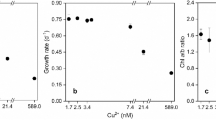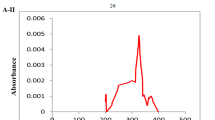Abstract
We investigated the effects of limiting (1.96 × 10−9 mol l−1 total Cu, corresponding to pCu 14.8; where pCu = −log [Cu2+]) and toxic Cu concentrations up to 8.0 × 10−5 mol l−1 total Cu (equivalent to pCu 9.5) on growth rates and photosynthetic activity of exponentially grown Phaeocystis cordata, using batch and semi-continuous cultures. With pulse amplitude modulated (PAM) fluorometry, we determined the photochemical response of P. cordata to the various Cu levels, and showed contrasting results for the batch and semi-continuous cultures. Although maximum photosystem II (PSII) quantum yield (ΦM) was optimal and constant in the semi-continuous P. cordata, the batch cultures showed a significant decrease in ΦM with culture age (0–72 h). The EC50 for the batch cultures was higher (2.0 × 10−10 mol l−1, pCu9.7), than that for the semi-continuous cultures (6.3 × 10−11 mol l−1, pCu10.2). The semi-continuous cultures exhibited a systematic and linear decrease in ΦM as Cu levels increased (for [Cu2+] < 1.0 × 10−12 mol l−1, pCu12.0), however, no effect of high Cu was observed on their operational PSII quantum yield (Φ′M). Similarly, semi-continuous cultures exhibited a significant decrease in ΦM, but not in Φ′M, because of low-Cu levels. Thus, Cu toxicity and Cu limitation damage the PSII reaction centers, but not the processes downstream of PSII. Quenching mechanisms (NPQ and Q n) were lower under high Cu relative to the controls, suggesting that toxic Cu impairs photo-protective mechanisms. PAM fluorometry is a sensitive tool for detecting minor physiological variations. However, culturing techniques (batch vs. semi-continuous) and sampling time might account for literature discrepancies on the effects of Cu on PSII. Semi-continuous culturing might be the most adequate technique to investigate Cu effects on PSII photochemistry.







Similar content being viewed by others
References
Andersen RA (2005) Algal culturing techniques. Elsevier Academic Press, London
Baron B, Arellano JB, Gorge JL (1995) Copper and photosystem II: a controversial relationship. Physiol Plantarum 94:174–180
Baumann HA, Morrison L, Stengel DB (2009) Metal accumulation and toxicity measured by PAM–chlorophyll fluorescence in seven species of marine macroalgae. Ecotox Environ Safety 72:1063–1075
Brown MT, Newman JE (2003) Physiological responses of Gracilariopsis longissima (S.G. Gmelin) Steentoft, L M Irvine and Farnham (Rhodophyceae) to sub-lethal copper concentrations. Aquatic Toxicol 64:201–213
Dewez D, Geoffroy L, Vernet G, Popovic R (2005) Determination of photosynthetic and enzymatic biomarkers sensitivity used to evaluate toxic effects of copper and fludioxonil in algal Scenedesmus obliquus. Aquatic Toxicol 74:150–159
Giardi MT, Koblizek M, Masojidek J (2001) Photosystem II-based biosensors for the detection of pollutants. Biosens Bioeletron 16:1027–1033
Guo J, Lapi S, Ruth TJ, Maldonado MT (2011) The interaction between Fe and Cu availability on the Cu requirements of diverse marine phytoplankton. J Phycol (in press)
Gupta R, He Z, Luan S (2002) Functional relationship of cytochrome c6 and plastocyanin in Arabidopsis. Nature 417:567–571
Juneau P, Harrison PJ (2005) Comparison by PAM fluorometry of photosynthetic activity of nine marine phytoplankton grown under identical conditions. Photochem Photobiol 81:649–653
Juneau P, Berdey El, Popovic R (2002) PAM fluorometry in the determination of the sensitivity of Chlorella vulgaris, Selenastrum capricornutum, and Chlamydomonas reinhardtii to copper. Arch Environ ContamToxicol 42:155–164
Krause GH, Jahns P (2003) Pulse amplitude modulated chlorophyll fluorometry and its application in plant science. In: Green BR, Parson WW (eds) Light harvesting antennas in photosynthesis. Kluwer Academic Publishers, Dordrecht, pp 373–399
Kromkamp JC, Forster RM (2003) The use of variable fluorescence measurements in aquatic ecosystems: differences between multiple and single turnover measuring protocols and suggested terminology. Eur J Phycol 38:103–112
Kupper H, Setlik I, Spiller M, Kupper FC, Prasil O (2002) Heavy metal induced inhibition of photosynthesis: targets of in vivo heavy metal chlorophyll formation. J Phycol 38:429–441
Kupper H, Setlik I, Setlikova E, Ferimazova N, Spiller M, Kupper FC (2003) Copper-induced inhibition of photosynthesis: limiting steps of in vivo copper chlorophyll formation in Scenedesmus quadricauda. Functional Plant Biol 30:1187–1196
Lombardi AT, Vieira AAH (2000) Copper complexation by Cyanophyta and Chlorophyta exudates. Phycologia 39:118–125
Maldonado MT, Allen AE, Chong JS, Lin K, Leus D, Karpenko N, Harris SL (2006) Copper-dependent iron transport in coastal and oceanic diatoms. Limnol Oceanogr 51:1729–1743
Mallik N, Mohn FH (2003) Use of chlorophyll fluorescence in metal-stress research: a case study with the green microalga Scenedesmus. Ecotoxicol Environ Safety 55:64–69
Maxwell K, Johnson GN (2000) Chlorophyll fluorescence: a practical guide. J Exp Bot 51:659–668
Miao AJ, Wang WX, Juneau P (2005) Comparison of Cd, Cu and Zn toxic effects on four marine phytoplankton by pulse-amplitude-modulated fluorometry. Environ Toxicol Chem 24:2603–2611
Nalewajko C, Olaveson NM (1995) Differential responses of growth, photosynthesis, respiration, and phosphate-uptake to copper in copper-tolerant and copper-intolerant strains of Scenedesmus acutus (Chlorophyceae). Can J Bot 73:1295–1303
Nriagu JO, Pacyna JM (1988) Quantitative assessment of worldwide contamination of air, water and soils by trace metals. Nature 333:134–139
Palenik B, Morel FMM (1991) Amine oxidases of marine phytoplankton. Appl Environ Microbiol 57:2440–2443
Peers G, Price NM (2006) Copper-containing plastocyanin used for electron transport by an oceanic diatom. Nature 441:341–344
Perales-Vela HV, Gonzalez-Moreno S, Mentes-Horcasitas C, Canizares-Villanueva RO (2007) Growth, photosynthetic and respiratory responses to sub-lethal copper concentrations in Scenedesmus incrassulatus (Chlorophyceae). Chemosphere 67:2274–2281
Price NM, Harrison GI, Hering JG, Hudson RJ, Nirel PMV, Palenik B, Morel FMM (1989) Preparation and chemistry of the artificial algal culture medium aquil. Biol Ocenogr 6:443–461
Raven JA, Evans MCW, Korb RE (1999) The role of trace metals in photosynthetic electron transport in O2-evolving organisms. Photosynth Res 60:111–149
Rochetta I, Kupper H (2009) Chromium- and copper-induced inhibition of photosynthesis in Euglena gracilis analysed on the single-cell level by fluorescence kinetic microscopy. New Phytol 182:405–420
Sunda WS, Huntsman SA (1983) Effect of competitive interactions between manganese and copper on cellular manganese and growth in estuarine and oceanic species of the diatom Thalassiosira. Limnol Oceanogr 28:924–934
Sunda WS, Huntsman SA (1998) Processes regulating cellular metal accumulation and physiological effects: phytoplankton as model systems. Science Total Environ 219:165–181
Trissl H-W, Lavergne J (1994) Fluorescence induction from photosystem II: analytical equations for yields of photochemistry and fluorescence derived from analysis of a model including exciton-radical pair equilibrium and restricted energy transfer between photosynthetic units. Aust J Plant Physiol 22:183–193
Wang W-X, Dei RCH (2006) Metal stoichiometry in predicting Cd and Cu toxicity to a freshwater green alga Chlamydomonas reinhardtii. Environ Pollut 142:303–312
Wiramanaden CIE (2006) Characterisation of copper binding ligands from marine cyanobacterial cultures using voltammetry and mass spectrometry. PhD thesis, University of British Columbia, Canada
Wiramanaden CIE, Cullen JT, Ross ARS, Orians KJ (2008) Cyanobacterial copper-binding ligands isolated from artificial seawater cultures. Mar Chem 110:28–41
Zhu S-H, Guo J, Maldonado MT, Green BR (2010) Effects of iron and copper deficiency on the expression of members of the light-harvesting family in the diatom Thalassiosira pseudonana (Bacillariophyceae). J Phycol 46:974–981
Acknowledgments
This research was supported by the Natural Sciences and Engineering Research Council of Canada (NSERC). Ana T. Lombardi is grateful to Conselho Nacional de Desenvolvimento Científico e Tecnológico (CNPq) for financial support (Proc. No. 200234/2008-0).
Author information
Authors and Affiliations
Corresponding author
Rights and permissions
About this article
Cite this article
Lombardi, A.T., Maldonado, M.T. The effects of copper on the photosynthetic response of Phaeocystis cordata . Photosynth Res 108, 77–87 (2011). https://doi.org/10.1007/s11120-011-9655-z
Received:
Accepted:
Published:
Issue Date:
DOI: https://doi.org/10.1007/s11120-011-9655-z




